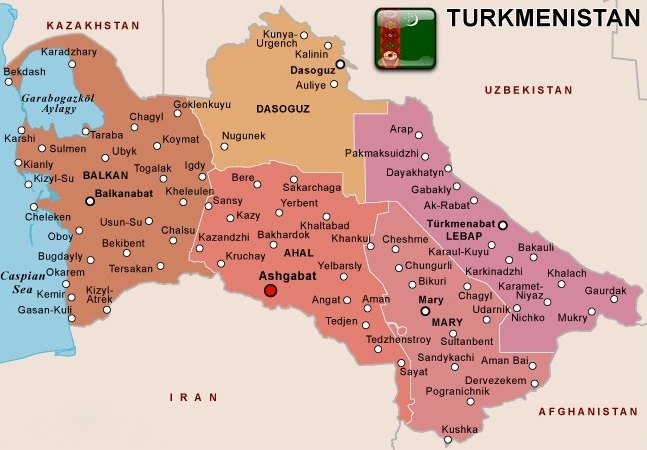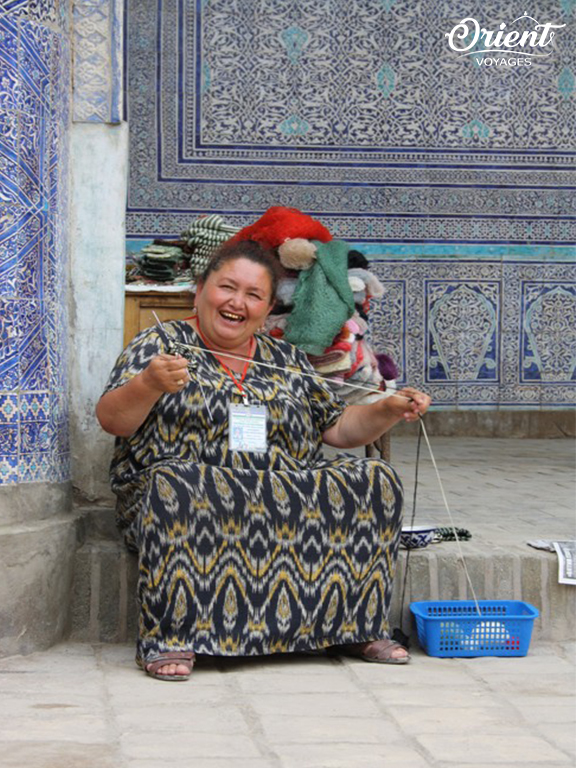-
Khiva, main gates Ota Darvaza
-
Khiva
-
Bukhara, Nodir Divan-Begi madrassah
-
Bukhara, Ark Fortress
-
Tashkent, Khast Imam Square
-
Bukhara
-
Samarkand, ensemble Shakhi Zinda
-
Bukhara, view on to Miri-Arab madrassah, XVI c.
-
Kyzylkum desert, riding on camels
-
Konigil village, silk paper center, noria
-
Sherdor madrassah, Samarkand
-
Samarkand, Registan Square
Turkmenistan
The country is situated in the southwest of Central Asia, bordered by Afghanistan and Iran in the south, Kazakhstan and Uzbekistan to the north, bordering the inland Caspian Sea to the west. The country has no outlet to the ocean. It is UN member from March 2, 1992. The country's capital is the city of Ashgabat.
On October 27, 1924 on national - state demarcation of the Soviet republics of Central Asia the territory was transformed into Turkmen SSR. On October 27, 1991, the Supreme Council of the Republic adopted the Declaration of Independence and approved the new name of the country - Turkmenistan.
Capital of Turkmenistan - Ashgabat is the largest administrative, political, industrial, scientific and cultural center of the state. Ashgabat is a separate administrative unit - the city with the rights of velayat (region). The city is located in the south of Turkmenistan, 25 km north of the border with Iran on Turan lowland.
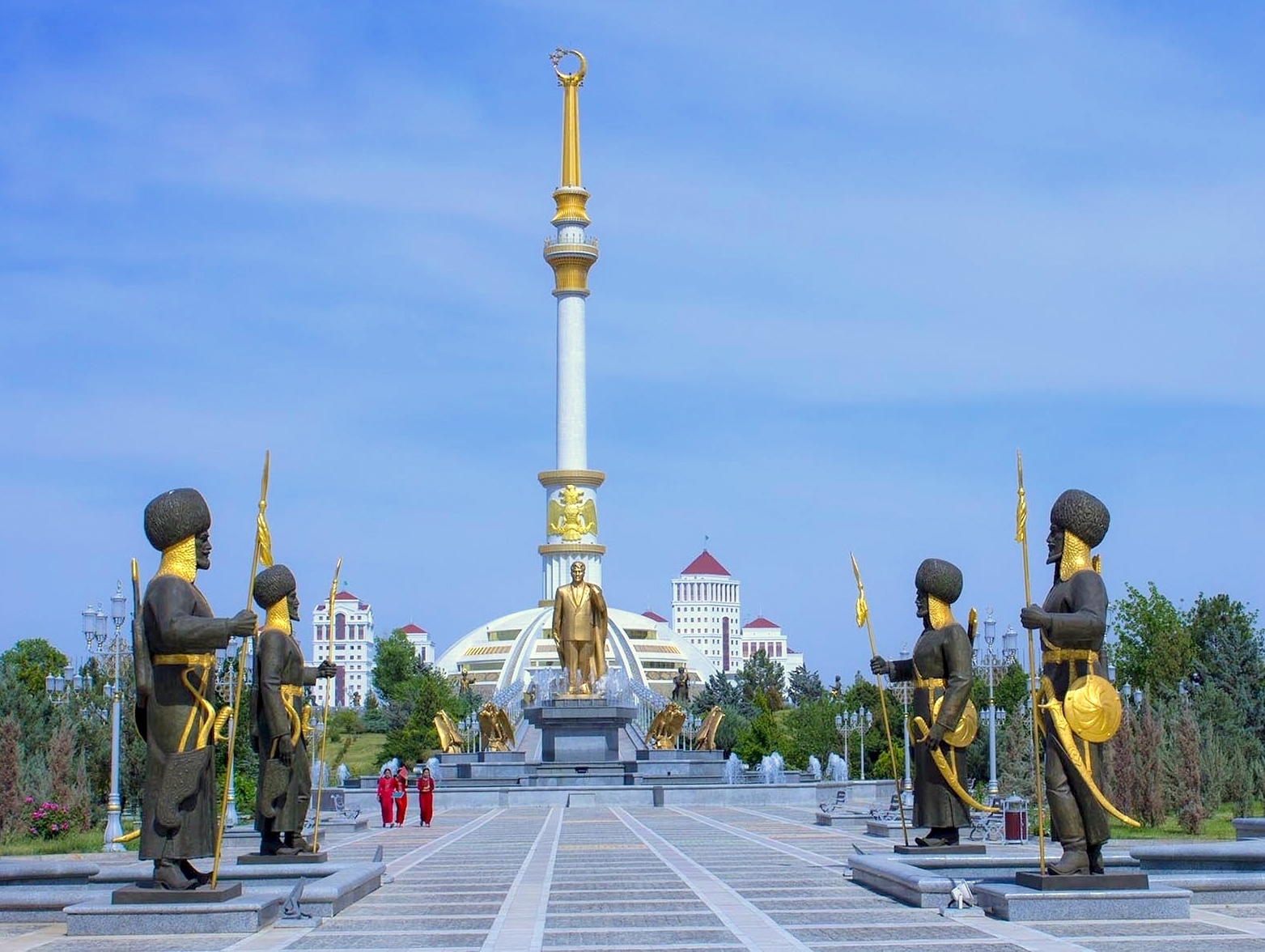 The city is located in the Akhal oasis in the Kopetdag foothill plain. According to official estimates about 12.5% of the population of Turkmenistan lives in Ashgabat. Buildings in Ashgabat are built mostly in the eastern architectural style. Almost all the houses, skyscrapers, mosques and sidewalks are decorated with beautiful marble. 5 km north of Ashgabat is located the famous bazaar "Dzhygyllyk" (Squash). Ashgabat has become the capital of Turkmenistan since October 1924. It is located on the Kopetdag foothill plain, at an altitude of 214-240 m. In 1927 it got its national name - Ashgabat.
The city is located in the Akhal oasis in the Kopetdag foothill plain. According to official estimates about 12.5% of the population of Turkmenistan lives in Ashgabat. Buildings in Ashgabat are built mostly in the eastern architectural style. Almost all the houses, skyscrapers, mosques and sidewalks are decorated with beautiful marble. 5 km north of Ashgabat is located the famous bazaar "Dzhygyllyk" (Squash). Ashgabat has become the capital of Turkmenistan since October 1924. It is located on the Kopetdag foothill plain, at an altitude of 214-240 m. In 1927 it got its national name - Ashgabat.
 The country has 3 international airports in the cities of Ashgabat (named after Saparmurat Turkmenbashi), Mary and Turkmenbashi. The state airline daily transports more than two thousand passengers within the country. International flights annually transport more than half a million people. The total length of railways is 3181 km. There are no electrified roads. Passenger traffic railways of Turkmenistan are limited by national borders of the country, except in the areas crossed by transit trains coming from Tajikistan to Uzbekistan and beyond. At the moment railway Kazakhstan-Turkmenistan-Iran is under construction.
The country has 3 international airports in the cities of Ashgabat (named after Saparmurat Turkmenbashi), Mary and Turkmenbashi. The state airline daily transports more than two thousand passengers within the country. International flights annually transport more than half a million people. The total length of railways is 3181 km. There are no electrified roads. Passenger traffic railways of Turkmenistan are limited by national borders of the country, except in the areas crossed by transit trains coming from Tajikistan to Uzbekistan and beyond. At the moment railway Kazakhstan-Turkmenistan-Iran is under construction.
Turkmenistan is characterized by continental climate of desert of a moderate type: long dry hot summer, cool and wet autumn and not cold winter with little snow. The duration of the winter period in the far north-east and south-west is - a month of the minimum and in the far north and north-east - more than 4 months. The average January temperature in the north-east is below -6 ° C; in the south-east and south-west is from + 3 °C to 5 °C. In July it varies within + 25 °, + 32 °. Turkmenistan is an area of insufficient moisture. On the plain area the annual rainfall is less than 150 mm; in the Aral Sea and Karabogazgol - less than 100 mm, and in mountainous areas - 350 mm. The development of agriculture in arid conditions is based solely on artificial irrigation.
Tourism is an industry that is growing rapidly in recent years. Medical tourism is especially intensively developed. This is primarily due to the creation of the tourist zone Avaza on the Caspian Sea. Each traveler must obtain a visa before arriving in Turkmenistan. To obtain a tourist visa, citizens of most countries require a visa support of the local travel agency.
Tours with visits to historic attractions and places such as Dashoguz, Konye-Urgench, Ashgabat, Nisa, Merv, Mary, beach tours in Avaza and medical tours and holidays in Mollakara (resort located in the Karakum Desert) Yyly Suva, Archman (Akhalt resort in the area known for its sulfur-sulfate-lime sources) are organized for tourists visiting Turkmenistan.
On the territory of Turkmenistan there are located three sites included in the list of UNESCO World Heritage Sites: Nisa, Ancient Merv and Konye-Urgench.
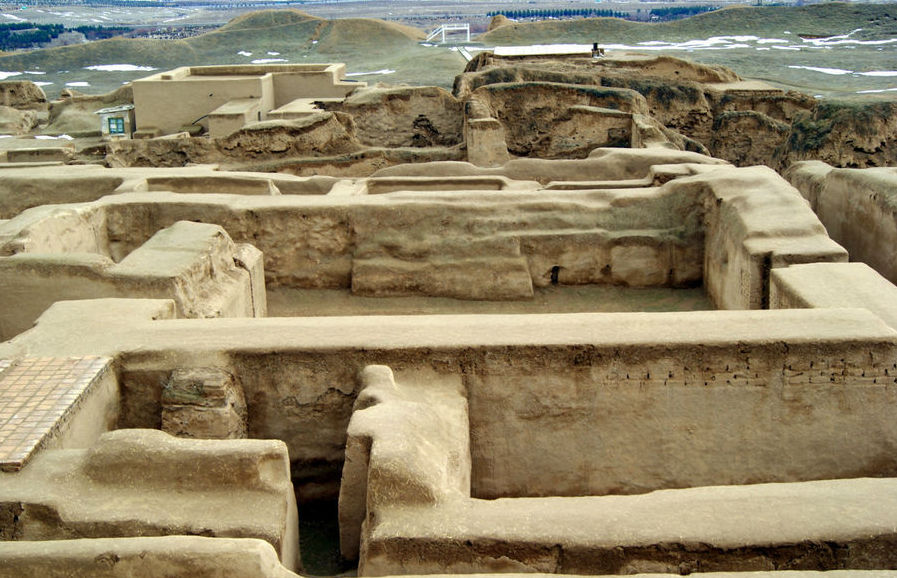 Nisa is the ancient and medieval city founded at the foot of the Kopetdag by the Parthians in the III BC. For the next six centuries it served as the paramount stronghold of Arshakid dynasty, and sometimes the capital of Parthia (under the name "Mihridatkirt" in honor of King Mithridates I).
Nisa is the ancient and medieval city founded at the foot of the Kopetdag by the Parthians in the III BC. For the next six centuries it served as the paramount stronghold of Arshakid dynasty, and sometimes the capital of Parthia (under the name "Mihridatkirt" in honor of King Mithridates I).
After the Sassanid coming to power the city fell into decay, and was revived in the Middle Ages as a trading center on the Silk Road.
In the X century the Samanid ruler Nuh II granted Nisa to Khorezm ruler Mamun. The city was ruled by Mamunids till the conquest of Khorezm by Mahmud Ghaznevi in 1017. The son of Mahmud, named Masud, was forced to yield Nisa to Seljuks invading Khorasan in 1035. In the XII century the city came under the power of the new dynasty of Khorezm shahs - Anushteginids. It remained in their hands until the Mongol invasion in 1220.
Since the XVI century Nisa had steadily declined and in 1820-es it was a ruin. Excavations that took place in Nisa led by the scientist M. Masson in 1946-1960, discovered the ruins of the columned hall, temples and fortifications, documents written in Aramaic script in the Parthian language, rich in evidence of everyday life of the Parthians, their Hellenistic art (for example, painted monumental statues of burnt clay). In 2007 the ruins of the Parthian fortress listed as UNESCO World Heritage Site.
.jpg) Merv is the oldest known city in Central Asia that was standing on the bank of the Murghab River in the southeastern part of Turkmenistan, 30 km to the east of the modern city of Mary. It arose in the middle of the 1st millennium BC. Merv reached its highest peak in the middle of the XII century, when Sultan Sanjar made it the capital of the Seljuk state. At this time Merv struck its contemporaries by scale of buildings and a huge population, which, according to some estimates, numbered more than the population of Constantinople and Baghdad. This city continued to be the largest center of Central Asia under the rule of Khorezmshahs as well. In 1221 Merv was destroyed by the Mongols and was not revived until the XV century, when the Temurids finally put in order its irrigation system. However Merv was unable to reach its former greatness; over time the settlement was moved to the site of the modern city of Mary. With the advent of the Russian army in 1880-es archaeological research of Merv oasis area began. It has acquired a systematic character in the postwar period through the work of M. Masson. The ruins of Merv are a monument to the World Heritage of Humanity.
Merv is the oldest known city in Central Asia that was standing on the bank of the Murghab River in the southeastern part of Turkmenistan, 30 km to the east of the modern city of Mary. It arose in the middle of the 1st millennium BC. Merv reached its highest peak in the middle of the XII century, when Sultan Sanjar made it the capital of the Seljuk state. At this time Merv struck its contemporaries by scale of buildings and a huge population, which, according to some estimates, numbered more than the population of Constantinople and Baghdad. This city continued to be the largest center of Central Asia under the rule of Khorezmshahs as well. In 1221 Merv was destroyed by the Mongols and was not revived until the XV century, when the Temurids finally put in order its irrigation system. However Merv was unable to reach its former greatness; over time the settlement was moved to the site of the modern city of Mary. With the advent of the Russian army in 1880-es archaeological research of Merv oasis area began. It has acquired a systematic character in the postwar period through the work of M. Masson. The ruins of Merv are a monument to the World Heritage of Humanity.
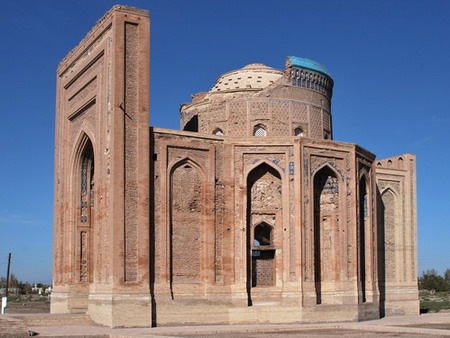 Konye-Urgench was the capital of Khorezm in the X-XIII and XIV centuries. Date of its foundation is unknown, but the remnants of the oldest fortress of the city "Kyrkmolla" refer to the ancient period (V-II centuries BC). The city is mentioned in the holy book of the Zoroastrians - Avesta under names "Urva" and "Urga". In Kangui period the city was known as "Hangird", "Hadzhird." At the end of the X century after joining the southern Khorezm to the northern Khorezm, Konye-Urgench became the capital of the United Khorezm State. In 1221 the city was taken and destroyed by the Mongols. In 1224 it came into possession of Juchi Khan and soon restored. Since the middle of the 13th century as part of the Golden Horde, the city had retained the value of trade craft and administrative center. In the middle of the 14th century Khorezm was freed from the power of the Golden Horde, and Urgench again became its capital. In 1388 it was destroyed by Temur. In 1391 territory was partially restored, but the former value was not reached; in the 17th century the city ceased to exist.
Konye-Urgench was the capital of Khorezm in the X-XIII and XIV centuries. Date of its foundation is unknown, but the remnants of the oldest fortress of the city "Kyrkmolla" refer to the ancient period (V-II centuries BC). The city is mentioned in the holy book of the Zoroastrians - Avesta under names "Urva" and "Urga". In Kangui period the city was known as "Hangird", "Hadzhird." At the end of the X century after joining the southern Khorezm to the northern Khorezm, Konye-Urgench became the capital of the United Khorezm State. In 1221 the city was taken and destroyed by the Mongols. In 1224 it came into possession of Juchi Khan and soon restored. Since the middle of the 13th century as part of the Golden Horde, the city had retained the value of trade craft and administrative center. In the middle of the 14th century Khorezm was freed from the power of the Golden Horde, and Urgench again became its capital. In 1388 it was destroyed by Temur. In 1391 territory was partially restored, but the former value was not reached; in the 17th century the city ceased to exist.
Konye-Urgench preserved mausoleum of Fakhraddin Razi (2nd half of the XII century), Mausoleum of Tekesh (the end of the XII - beginning of the XIII centuries), the minaret of Qutlugh Temur (1321-1333), Khanaka - three-domed portal structure with mausoleum of Nadzhmeddin Kubra (1st third of the XIV century), portal of caravanserai of the XIV century. In 2005 monuments were included in the UNESCO World Heritage List.
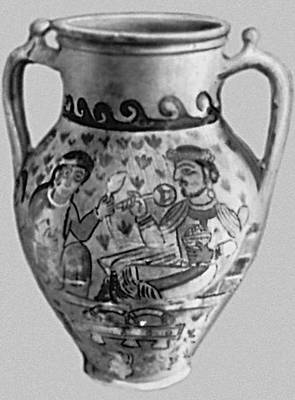 Margiana (Greek Margiane, Old Persian Margush) is the name of an ancient region in Central Asia, adrift the river Murghab (now the southeast of Turkmenistan and northern Afghanistan). Margiana was first mentioned in Avesta and Behistun inscription. Margiana bordered in the west with Parthia, in the north-east - with Sogdiana, in the east - with Bactria, in the south - Areya. Capital of Margiana was situated in the area of Ancient Merv. In 522 BC population uprising against the power of the Achaemenids occurred in Margiana. Rebellion was suppressed by king Darius I (521). Later it became a part of Alexander the Great Power, the Seleucid state and Parthia. In the Middle Ages the land Margiana became part of Khorasan.
Margiana (Greek Margiane, Old Persian Margush) is the name of an ancient region in Central Asia, adrift the river Murghab (now the southeast of Turkmenistan and northern Afghanistan). Margiana was first mentioned in Avesta and Behistun inscription. Margiana bordered in the west with Parthia, in the north-east - with Sogdiana, in the east - with Bactria, in the south - Areya. Capital of Margiana was situated in the area of Ancient Merv. In 522 BC population uprising against the power of the Achaemenids occurred in Margiana. Rebellion was suppressed by king Darius I (521). Later it became a part of Alexander the Great Power, the Seleucid state and Parthia. In the Middle Ages the land Margiana became part of Khorasan.
In the 1st third of the 1st millennium BC urban settlements (Yaz-Depe) arise in Margiana. In the middle of the 1st millennium BC cities were encircled with walls (Merv). In the III century BC influence of Hellenistic culture penetrated in the art of Margiana. In the heyday (II century BC - III century AD) the towns and fortresses of Margiana were built on a regular plan, sometimes with a "corrugated" walls (Chilburdzh). Combining multiple dwellings in one yard is a typical characteristic of a residential house (Jin-Depe); common terracotta figurines, ossuaries in the form of architectural structures are also spread.
The monuments of Buddhist architecture and sculpture refer to the III century. Margiana artistic traditions are developed in the art of Merv.
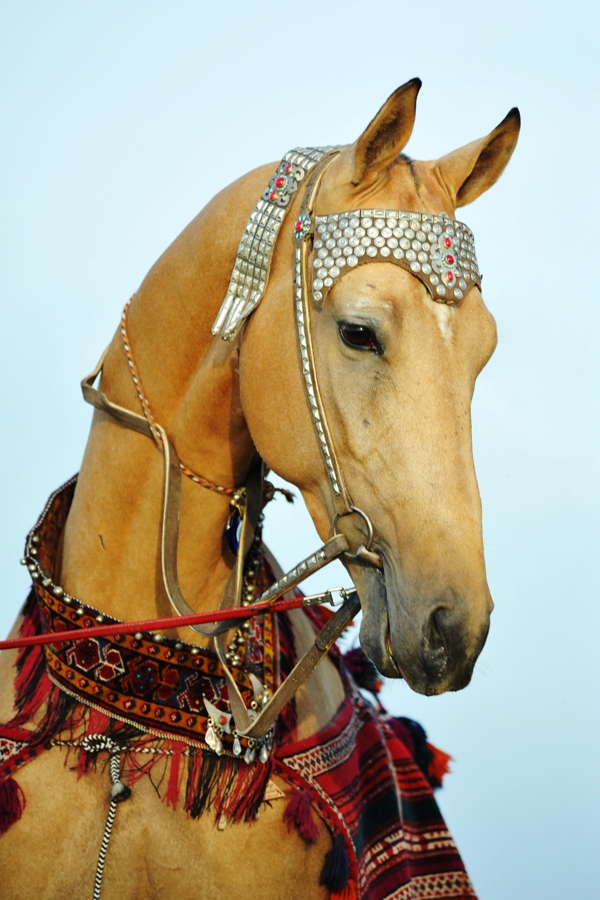 Famous "swift as the wind" Ahaltekes glorified the country all over the world. Even the state coat of arms depicts the Akhal-Teke horses. This is truly a unique breed - fast, graceful, with chiseled "swan" neck and thin "dry" feet, these horses at the same time are surprisingly hardy. Over the centuries the Turkmens highly valued good horses and considered them their friends. This passion is preserved to the present day, and now the horse is one of the main attractions of the country.
Famous "swift as the wind" Ahaltekes glorified the country all over the world. Even the state coat of arms depicts the Akhal-Teke horses. This is truly a unique breed - fast, graceful, with chiseled "swan" neck and thin "dry" feet, these horses at the same time are surprisingly hardy. Over the centuries the Turkmens highly valued good horses and considered them their friends. This passion is preserved to the present day, and now the horse is one of the main attractions of the country.
On October 27, 1924 on national - state demarcation of the Soviet republics of Central Asia the territory was transformed into Turkmen SSR. On October 27, 1991, the Supreme Council of the Republic adopted the Declaration of Independence and approved the new name of the country - Turkmenistan.
Capital of Turkmenistan - Ashgabat is the largest administrative, political, industrial, scientific and cultural center of the state. Ashgabat is a separate administrative unit - the city with the rights of velayat (region). The city is located in the south of Turkmenistan, 25 km north of the border with Iran on Turan lowland.
 The city is located in the Akhal oasis in the Kopetdag foothill plain. According to official estimates about 12.5% of the population of Turkmenistan lives in Ashgabat. Buildings in Ashgabat are built mostly in the eastern architectural style. Almost all the houses, skyscrapers, mosques and sidewalks are decorated with beautiful marble. 5 km north of Ashgabat is located the famous bazaar "Dzhygyllyk" (Squash). Ashgabat has become the capital of Turkmenistan since October 1924. It is located on the Kopetdag foothill plain, at an altitude of 214-240 m. In 1927 it got its national name - Ashgabat.
The city is located in the Akhal oasis in the Kopetdag foothill plain. According to official estimates about 12.5% of the population of Turkmenistan lives in Ashgabat. Buildings in Ashgabat are built mostly in the eastern architectural style. Almost all the houses, skyscrapers, mosques and sidewalks are decorated with beautiful marble. 5 km north of Ashgabat is located the famous bazaar "Dzhygyllyk" (Squash). Ashgabat has become the capital of Turkmenistan since October 1924. It is located on the Kopetdag foothill plain, at an altitude of 214-240 m. In 1927 it got its national name - Ashgabat. The country has 3 international airports in the cities of Ashgabat (named after Saparmurat Turkmenbashi), Mary and Turkmenbashi. The state airline daily transports more than two thousand passengers within the country. International flights annually transport more than half a million people. The total length of railways is 3181 km. There are no electrified roads. Passenger traffic railways of Turkmenistan are limited by national borders of the country, except in the areas crossed by transit trains coming from Tajikistan to Uzbekistan and beyond. At the moment railway Kazakhstan-Turkmenistan-Iran is under construction.
The country has 3 international airports in the cities of Ashgabat (named after Saparmurat Turkmenbashi), Mary and Turkmenbashi. The state airline daily transports more than two thousand passengers within the country. International flights annually transport more than half a million people. The total length of railways is 3181 km. There are no electrified roads. Passenger traffic railways of Turkmenistan are limited by national borders of the country, except in the areas crossed by transit trains coming from Tajikistan to Uzbekistan and beyond. At the moment railway Kazakhstan-Turkmenistan-Iran is under construction.Turkmenistan is characterized by continental climate of desert of a moderate type: long dry hot summer, cool and wet autumn and not cold winter with little snow. The duration of the winter period in the far north-east and south-west is - a month of the minimum and in the far north and north-east - more than 4 months. The average January temperature in the north-east is below -6 ° C; in the south-east and south-west is from + 3 °C to 5 °C. In July it varies within + 25 °, + 32 °. Turkmenistan is an area of insufficient moisture. On the plain area the annual rainfall is less than 150 mm; in the Aral Sea and Karabogazgol - less than 100 mm, and in mountainous areas - 350 mm. The development of agriculture in arid conditions is based solely on artificial irrigation.
Tourism is an industry that is growing rapidly in recent years. Medical tourism is especially intensively developed. This is primarily due to the creation of the tourist zone Avaza on the Caspian Sea. Each traveler must obtain a visa before arriving in Turkmenistan. To obtain a tourist visa, citizens of most countries require a visa support of the local travel agency.
Tours with visits to historic attractions and places such as Dashoguz, Konye-Urgench, Ashgabat, Nisa, Merv, Mary, beach tours in Avaza and medical tours and holidays in Mollakara (resort located in the Karakum Desert) Yyly Suva, Archman (Akhalt resort in the area known for its sulfur-sulfate-lime sources) are organized for tourists visiting Turkmenistan.
On the territory of Turkmenistan there are located three sites included in the list of UNESCO World Heritage Sites: Nisa, Ancient Merv and Konye-Urgench.
 Nisa is the ancient and medieval city founded at the foot of the Kopetdag by the Parthians in the III BC. For the next six centuries it served as the paramount stronghold of Arshakid dynasty, and sometimes the capital of Parthia (under the name "Mihridatkirt" in honor of King Mithridates I).
Nisa is the ancient and medieval city founded at the foot of the Kopetdag by the Parthians in the III BC. For the next six centuries it served as the paramount stronghold of Arshakid dynasty, and sometimes the capital of Parthia (under the name "Mihridatkirt" in honor of King Mithridates I).After the Sassanid coming to power the city fell into decay, and was revived in the Middle Ages as a trading center on the Silk Road.
In the X century the Samanid ruler Nuh II granted Nisa to Khorezm ruler Mamun. The city was ruled by Mamunids till the conquest of Khorezm by Mahmud Ghaznevi in 1017. The son of Mahmud, named Masud, was forced to yield Nisa to Seljuks invading Khorasan in 1035. In the XII century the city came under the power of the new dynasty of Khorezm shahs - Anushteginids. It remained in their hands until the Mongol invasion in 1220.
Since the XVI century Nisa had steadily declined and in 1820-es it was a ruin. Excavations that took place in Nisa led by the scientist M. Masson in 1946-1960, discovered the ruins of the columned hall, temples and fortifications, documents written in Aramaic script in the Parthian language, rich in evidence of everyday life of the Parthians, their Hellenistic art (for example, painted monumental statues of burnt clay). In 2007 the ruins of the Parthian fortress listed as UNESCO World Heritage Site.
.jpg) Merv is the oldest known city in Central Asia that was standing on the bank of the Murghab River in the southeastern part of Turkmenistan, 30 km to the east of the modern city of Mary. It arose in the middle of the 1st millennium BC. Merv reached its highest peak in the middle of the XII century, when Sultan Sanjar made it the capital of the Seljuk state. At this time Merv struck its contemporaries by scale of buildings and a huge population, which, according to some estimates, numbered more than the population of Constantinople and Baghdad. This city continued to be the largest center of Central Asia under the rule of Khorezmshahs as well. In 1221 Merv was destroyed by the Mongols and was not revived until the XV century, when the Temurids finally put in order its irrigation system. However Merv was unable to reach its former greatness; over time the settlement was moved to the site of the modern city of Mary. With the advent of the Russian army in 1880-es archaeological research of Merv oasis area began. It has acquired a systematic character in the postwar period through the work of M. Masson. The ruins of Merv are a monument to the World Heritage of Humanity.
Merv is the oldest known city in Central Asia that was standing on the bank of the Murghab River in the southeastern part of Turkmenistan, 30 km to the east of the modern city of Mary. It arose in the middle of the 1st millennium BC. Merv reached its highest peak in the middle of the XII century, when Sultan Sanjar made it the capital of the Seljuk state. At this time Merv struck its contemporaries by scale of buildings and a huge population, which, according to some estimates, numbered more than the population of Constantinople and Baghdad. This city continued to be the largest center of Central Asia under the rule of Khorezmshahs as well. In 1221 Merv was destroyed by the Mongols and was not revived until the XV century, when the Temurids finally put in order its irrigation system. However Merv was unable to reach its former greatness; over time the settlement was moved to the site of the modern city of Mary. With the advent of the Russian army in 1880-es archaeological research of Merv oasis area began. It has acquired a systematic character in the postwar period through the work of M. Masson. The ruins of Merv are a monument to the World Heritage of Humanity. Konye-Urgench was the capital of Khorezm in the X-XIII and XIV centuries. Date of its foundation is unknown, but the remnants of the oldest fortress of the city "Kyrkmolla" refer to the ancient period (V-II centuries BC). The city is mentioned in the holy book of the Zoroastrians - Avesta under names "Urva" and "Urga". In Kangui period the city was known as "Hangird", "Hadzhird." At the end of the X century after joining the southern Khorezm to the northern Khorezm, Konye-Urgench became the capital of the United Khorezm State. In 1221 the city was taken and destroyed by the Mongols. In 1224 it came into possession of Juchi Khan and soon restored. Since the middle of the 13th century as part of the Golden Horde, the city had retained the value of trade craft and administrative center. In the middle of the 14th century Khorezm was freed from the power of the Golden Horde, and Urgench again became its capital. In 1388 it was destroyed by Temur. In 1391 territory was partially restored, but the former value was not reached; in the 17th century the city ceased to exist.
Konye-Urgench was the capital of Khorezm in the X-XIII and XIV centuries. Date of its foundation is unknown, but the remnants of the oldest fortress of the city "Kyrkmolla" refer to the ancient period (V-II centuries BC). The city is mentioned in the holy book of the Zoroastrians - Avesta under names "Urva" and "Urga". In Kangui period the city was known as "Hangird", "Hadzhird." At the end of the X century after joining the southern Khorezm to the northern Khorezm, Konye-Urgench became the capital of the United Khorezm State. In 1221 the city was taken and destroyed by the Mongols. In 1224 it came into possession of Juchi Khan and soon restored. Since the middle of the 13th century as part of the Golden Horde, the city had retained the value of trade craft and administrative center. In the middle of the 14th century Khorezm was freed from the power of the Golden Horde, and Urgench again became its capital. In 1388 it was destroyed by Temur. In 1391 territory was partially restored, but the former value was not reached; in the 17th century the city ceased to exist.Konye-Urgench preserved mausoleum of Fakhraddin Razi (2nd half of the XII century), Mausoleum of Tekesh (the end of the XII - beginning of the XIII centuries), the minaret of Qutlugh Temur (1321-1333), Khanaka - three-domed portal structure with mausoleum of Nadzhmeddin Kubra (1st third of the XIV century), portal of caravanserai of the XIV century. In 2005 monuments were included in the UNESCO World Heritage List.
 Margiana (Greek Margiane, Old Persian Margush) is the name of an ancient region in Central Asia, adrift the river Murghab (now the southeast of Turkmenistan and northern Afghanistan). Margiana was first mentioned in Avesta and Behistun inscription. Margiana bordered in the west with Parthia, in the north-east - with Sogdiana, in the east - with Bactria, in the south - Areya. Capital of Margiana was situated in the area of Ancient Merv. In 522 BC population uprising against the power of the Achaemenids occurred in Margiana. Rebellion was suppressed by king Darius I (521). Later it became a part of Alexander the Great Power, the Seleucid state and Parthia. In the Middle Ages the land Margiana became part of Khorasan.
Margiana (Greek Margiane, Old Persian Margush) is the name of an ancient region in Central Asia, adrift the river Murghab (now the southeast of Turkmenistan and northern Afghanistan). Margiana was first mentioned in Avesta and Behistun inscription. Margiana bordered in the west with Parthia, in the north-east - with Sogdiana, in the east - with Bactria, in the south - Areya. Capital of Margiana was situated in the area of Ancient Merv. In 522 BC population uprising against the power of the Achaemenids occurred in Margiana. Rebellion was suppressed by king Darius I (521). Later it became a part of Alexander the Great Power, the Seleucid state and Parthia. In the Middle Ages the land Margiana became part of Khorasan.In the 1st third of the 1st millennium BC urban settlements (Yaz-Depe) arise in Margiana. In the middle of the 1st millennium BC cities were encircled with walls (Merv). In the III century BC influence of Hellenistic culture penetrated in the art of Margiana. In the heyday (II century BC - III century AD) the towns and fortresses of Margiana were built on a regular plan, sometimes with a "corrugated" walls (Chilburdzh). Combining multiple dwellings in one yard is a typical characteristic of a residential house (Jin-Depe); common terracotta figurines, ossuaries in the form of architectural structures are also spread.
The monuments of Buddhist architecture and sculpture refer to the III century. Margiana artistic traditions are developed in the art of Merv.
 Famous "swift as the wind" Ahaltekes glorified the country all over the world. Even the state coat of arms depicts the Akhal-Teke horses. This is truly a unique breed - fast, graceful, with chiseled "swan" neck and thin "dry" feet, these horses at the same time are surprisingly hardy. Over the centuries the Turkmens highly valued good horses and considered them their friends. This passion is preserved to the present day, and now the horse is one of the main attractions of the country.
Famous "swift as the wind" Ahaltekes glorified the country all over the world. Even the state coat of arms depicts the Akhal-Teke horses. This is truly a unique breed - fast, graceful, with chiseled "swan" neck and thin "dry" feet, these horses at the same time are surprisingly hardy. Over the centuries the Turkmens highly valued good horses and considered them their friends. This passion is preserved to the present day, and now the horse is one of the main attractions of the country.REFERENCE
State structure of Turkmenistan
Turkmenistan is a presidential republic with a one-party system, which consists of 5 provinces and Ashgabat - the city with the rights of the region (velayat). Legislature is represented by Mejlis (parliament, 125 members).
Currency - manat.
Administrative division of Turkmenistan
Administratively Turkmenistan consists of 6 administrative-territorial units, 5 of which are provinces, 1 is the city with the rights of a province (velayat):
Akhal velayat. Capital - Annaou.
Balkan province. Capital - Balkanabad (Nebit Dag).
Dashoguz. Capital - Dashoguz (Tashauz).
Lebap province. Capital - Turkmenabat (Chardzhou).
Mary province. Capital - Mary.
Ashgabat city.
Economy of Turkmenistan
With its large reserves of natural gas (15-20 trillion cu. M) and oil (1.5-2.0 billion tons), Turkmenistan is one of the major exporters of fuel resources. This sector generates about 70% of the gross national product. The main industries include cleaning and processing of oil and natural gas; production of glass, tissue (mainly cotton) and garments; food industry.
Population: more than 5 million people. (2012)
Religion
The vast majority of Turkmenistan population is Muslim (mostly Sunni) - 89%. Christians are about 9% of the population; the other confessions make up 2%.
Language
The official language of Turkmenistan is Turkmen.
Public holidays
New Year - January 1
Day of Remembrance - January 12
National Flag Day of Turkmenistan - February 19
International Women's Day - March 8
National holiday of spring - March 21-22
Day of Victory in the Great Patriotic War of 1941-1945 - May 9
Day of Revival, Unity and Poetry of Magtymguly Fragi- May 18
National Day of Commemoration - October 6
Independence Day of Turkmenistan - October 27-28
Turkmenistan's national holiday - Neutrality Day - December 12
Kurban Bayram and Bayram Oraza
Turkmenistan is a presidential republic with a one-party system, which consists of 5 provinces and Ashgabat - the city with the rights of the region (velayat). Legislature is represented by Mejlis (parliament, 125 members).
Currency - manat.
Administrative division of Turkmenistan
Administratively Turkmenistan consists of 6 administrative-territorial units, 5 of which are provinces, 1 is the city with the rights of a province (velayat):
Akhal velayat. Capital - Annaou.
Balkan province. Capital - Balkanabad (Nebit Dag).
Dashoguz. Capital - Dashoguz (Tashauz).
Lebap province. Capital - Turkmenabat (Chardzhou).
Mary province. Capital - Mary.
Ashgabat city.
Economy of Turkmenistan
With its large reserves of natural gas (15-20 trillion cu. M) and oil (1.5-2.0 billion tons), Turkmenistan is one of the major exporters of fuel resources. This sector generates about 70% of the gross national product. The main industries include cleaning and processing of oil and natural gas; production of glass, tissue (mainly cotton) and garments; food industry.
Population: more than 5 million people. (2012)
Religion
The vast majority of Turkmenistan population is Muslim (mostly Sunni) - 89%. Christians are about 9% of the population; the other confessions make up 2%.
Language
The official language of Turkmenistan is Turkmen.
Public holidays
New Year - January 1
Day of Remembrance - January 12
National Flag Day of Turkmenistan - February 19
International Women's Day - March 8
National holiday of spring - March 21-22
Day of Victory in the Great Patriotic War of 1941-1945 - May 9
Day of Revival, Unity and Poetry of Magtymguly Fragi- May 18
National Day of Commemoration - October 6
Independence Day of Turkmenistan - October 27-28
Turkmenistan's national holiday - Neutrality Day - December 12
Kurban Bayram and Bayram Oraza
Visa
Each traveler must obtain a visa before arriving in Turkmenistan. To obtain a tourist visa, citizens of most countries require a visa support of the local travel agency.
Customs regulations
Import and export of local currency is prohibited. Import of foreign currency is unlimited (the number must be specified in the declaration). You can take out an amount not exceeding specified in the declaration.
Each traveler must obtain a visa before arriving in Turkmenistan. To obtain a tourist visa, citizens of most countries require a visa support of the local travel agency.
Customs regulations
Import and export of local currency is prohibited. Import of foreign currency is unlimited (the number must be specified in the declaration). You can take out an amount not exceeding specified in the declaration.
Passengers over the age of 16 years are allowed duty free import of 200 cigarettes or 200 grams of tobacco; up to 2 liters of any alcoholic beverages (for persons over 21 years); as well as personal items in reasonable quantities.
When entering the country one must fill in the customs declaration, which must be retained until departure. This facilitates the subsequent export of objects and items for personal use, including currency and valuables, which must be specified in the declaration. Customs inspection is usually sufficiently long and detailed. It is recommended to keep receipts of currency exchange and checks from stores. This will facilitate the export of goods purchased in the country, especially if they had been paid for in foreign currency.
Import and export of weapons, ammunition and drugs is prohibited. Works of art and antiques can be imported and exported only with the permission of the Ministry of Culture. Export of carpets, jewelry, musical instruments, art and archaeological exhibits, and so is only possible if you have the documents confirming the legality of the purchase. For the export of carpets from Turkmenistan you must also obtain a certificate from the Carpet Museum in Ashgabat that the carpet has no historical value. In addition, you will have to pay tax which depends on the size of the carpet.
When entering the country one must fill in the customs declaration, which must be retained until departure. This facilitates the subsequent export of objects and items for personal use, including currency and valuables, which must be specified in the declaration. Customs inspection is usually sufficiently long and detailed. It is recommended to keep receipts of currency exchange and checks from stores. This will facilitate the export of goods purchased in the country, especially if they had been paid for in foreign currency.
Import and export of weapons, ammunition and drugs is prohibited. Works of art and antiques can be imported and exported only with the permission of the Ministry of Culture. Export of carpets, jewelry, musical instruments, art and archaeological exhibits, and so is only possible if you have the documents confirming the legality of the purchase. For the export of carpets from Turkmenistan you must also obtain a certificate from the Carpet Museum in Ashgabat that the carpet has no historical value. In addition, you will have to pay tax which depends on the size of the carpet.
Helpful information
Internet domain - tm
Telephone code - 993
Voltage - 220 V AC, 50 A; standard two-pin plug socket
Time: GMT + 5:00
Internet domain - tm
Telephone code - 993
Voltage - 220 V AC, 50 A; standard two-pin plug socket
Time: GMT + 5:00

Review 

Dear Anastasiya,
I want to thank you, in behalf of my sister and I, for organizing the tour for us. We enjoyed it very much.
You, the guides and the drivers, ...
all reviews
all reviews



